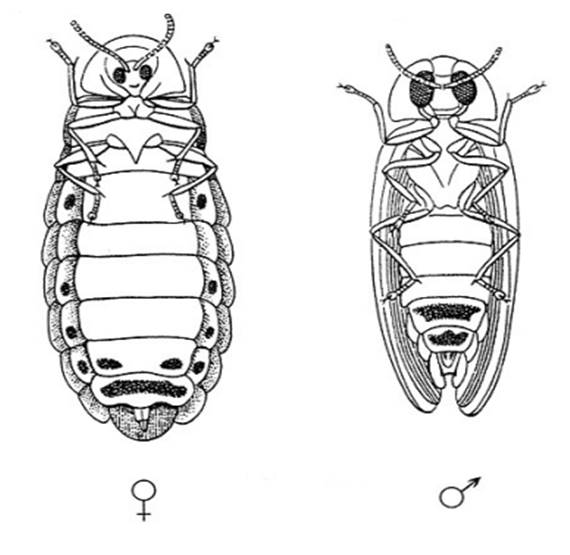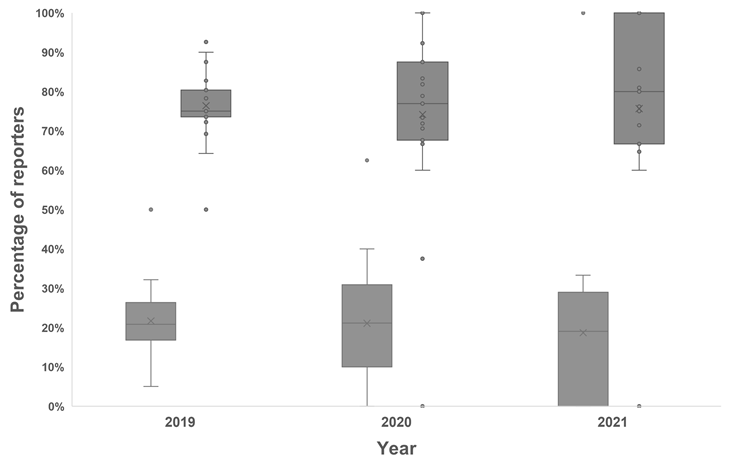INTRODUCTION
Insects are among the groups of organisms most likely to be affected by anthropogenic impacts and climate change, because of the direct influence these factors have on their development, reproduction, and survival[1-[3]. Fireflies (Coleoptera: Lampyridae) are among the most charismatic of all insects, and their spectacular courtship lit flights have inspired ordinary citizens, artists, poets and scientists alike. With more than 2 000 species in 100 genera, the worldwide diversity of lampyrids is impressive and includes both diurnal and nocturnal species[4-[6]. They are true beetles that exhibit a distinct sexual dimorphism. For example, in Lamprohiza splendidula L. males are winged and fly while females mostly have only wing stumps incapable of flying[7]. Light organs are located on the underside of the body and light organ patterns differ depending on sex (Fig. 1). Fireflies, like numerous other insects, have experienced declines in their distribution and abundance worldwide[8]. Although they are widely known in society, especially due to the folkloric legends and association with warm summer evenings in childhood, fireflies continue to be loved and appreciated, despite it being an under-researched insect from a scientific viewpoint worldwide. Courtship in European lampyrids is simple and involves bioluminescent displays in which flying males are attracted to sedentary females that emit an uninterrupted bioluminescent glow[8]. Once females have mated, they generally cease to glow[8]. Both males and females of lampyrids are active for about an hour after sunset or until mating ends. There is variation in the glow patterns (i.e., continuous or intermittent) of Lampyris, Geoffroy, 1762 species males, with variation noted within species depending on the pattern and timing of display[9].
FIREFLY SPECIES OVERVIEW
Currently, 64 species of fireflies are known to occur in continental Europe[9; p.164-165]. The Catalogue of Palaearctic Coleoptera[10] mentions the occurrence of eight species of lampyrids in Croatia: Lampyris germariensis Jacquelin du Val, 1860; Lampyris noctiluca Linnaeus, 1767; Lampyris zenkeri Germar, 1817; Lamprohiza germari Küster, 1844; Lamprohiza splendidula Linnaeus, 1767; Phosphaenus hemipterus Geoffroy, 1762; Luciola italica Linnaeus, 1767 and Luciola lusitanica Charpentier, 1825. Voucher specimens of the listed species are found in the Croatian Natural History Museum in Zagreb and are part of the collections of Đ. Koča, I. Novak, P. Novak, R. Weingartner, R. Mikšić, K. I. Igalfy, V. Redenšek and F. Perović. To date, there are no empirical data in Croatia, as no official surveys have been conducted or published for species present, and there is no checklist of Croatian lampyrids. Only recently have European Lampyridae experts gained access to these collections and reviewed them for accuracy according to current taxonomic standards and naming conventions[11]-[13]
Detailed empirical data on lampyrids in Europe are limited to a few recent studies detailing the basic biology and ecology of even the most common fireflies, primarily by a few notable authors in the field (e.g.[10] ,[14] and more recently[19] ,[11] -[13] ,[15] -[18] . Moreover, there is a lack of information on the distribution and species diversity of lampyrids not only for Croatia, but for the whole of southeastern Europe[11] . According to De Cock[19] , four species of lampyrids are most common and widespread in Europe: L. noctiluca, L. splendidula, P. hemipterus, and L. lusitanica. Therefore, it is reasonable to assume that these species are also the most common in Croatia.
CITIZEN SCIENCE PROJECT AND INITIATIVE “KREŠO THE FIREFLY”
Citizen science (CS) has become a popular means to address large scale scientific questions because it allows for the collection of basic scientific data that an individual or small group of scientists would not be able to conduct due to limited research funds, time, and personnel. CS is the participation of the public in scientific data collection on a particular topic with a specific goal[19] . CS is a popular means of not only informing the general, non-scientific public about important issues in science, but also educating the public and generating data and new knowledge without the usual high costs associated with conducting primary research, e.g.[20] . Well-known citizen science campaigns in entomology include the studies of Pocock and Evans[21] , Kampen et al.[22] and Dennis et al.[23] . For fireflies in Europe, there are a number of successful citizen science campaigns targeting firefly’s occurrences in Spain[16] , Portugal[18] and Italy[24] . The data retained by the researchers and presented in scientific papers addresses the basic ecology of fireflies and provide information on the distribution and abundance of various European firefly species.
It is suspected that most emerging issues in biodiversity conservation is caused by new biological and digital technologies, new pollutants, and invasive species, climate change and potential human responses to it[25] . Light pollution affects the reproduction and migration of insects, amphibians, fish, birds, bats, and other animals, and can disrupt plants by distorting their natural day-night cycle[26] . Also, there is a growing awareness of light pollution, presence of artificial (anthropogenic) light, that is known to harm nocturnal species[27] . Over 30 % of all vertebrates and more than 60 % of all invertebrates in the world's biodiversity are nocturnal species. Artificial light threatens biodiversity by altering the nocturnal behaviour of organisms, such as insects attracted to streetlights. In Germany, each streetlight kills about 6.8 million insects every night in summer[26] . Fireflies live in damp and warm places, such as forested lakes, rivers or wetlands, by the sea or forest paths. Habitat loss has always been highlighted as one of the major threats, especially as a consequence of deforestation and urban expansion[28] ,[29] . Sexual communication in fireflies involves the emission and perception of the combination of bioluminescent cues and/or pheromones and is finely tuned depending on the species, environment, and time of day in which they occur[30] ,[31] . It is known that artificial light makes it difficult for fireflies to communicate and thus reduces the chances of mating, which affects future generations of fireflies[27] .
Concerned students and scientists of University of Zagreb Faculty of Agriculture (Croatia) and University of Wollongong (Australia) launched a citizen science initiative called “Krešo the Firefly”. The aim of the campaign was to collect as much data as possible to answer three specific questions about Lampyrids in Croatia: i) where are they located; ii) how abundant are they throughout Croatia and iii) what is the basic demographic profile of the citizen scientists.
FROM CITIZEN SCIENCE TO OPEN DATA
The concept of open data has started to become more and more prevalent in both government and private sector context, but also in science and citizen initiatives. In the last 10-15 years a number of open data initiatives have been launched with the aim of increasing the efficiency and transparency of governments, solving simple questions raised by citizens and local communities to name a few[32] . Open data should adhere to several principles in order to be considered open such as being complete, accessible in machine-readable format, license-free and free of charge[33] ,[34] .
As principles of open data are being introduced into the Croatian scientific community[35] and public institutions and government departments[36] , this presents an opportunity for increasing the availability and reuse of occurrence data of fireflies. To be able to analyse the datasets generated in the project, making the data available open, accessible and in machine-readable formats would increase usability of the collected data as well as assist scientists, natural resource managers and policy makers protect and restore firefly diversity in Croatia. As stated by Bonney et al.[37] those who seek to build capacity in the citizen science field can help by developing and improving open-source data management technologies to those already available in other fields of science.
There are some data on fireflies’ form various publishers, e.g.[38] -[44] available in the Global Biodiversity Information Facility (GBIF), an international network and data infrastructure funded by the world's governments. Its goal is to provide open access to data on all species of life on Earth. Of Lampyridae species, there are a total of 34 records on the territory of Croatia, Austria, Slovenia and Bosnia and Herzegovina, including L. noctiluca (24), L. zenkeri (5), L. germariensis (2) and three unidentified species. The base of records presented on GBIF shows either human observations, occurrences or preservation/material specimens. No data are available on the number of fireflies in a given area or on the individual who made the taxonomic identification[45] .
METHODOLOGY
DATA COLLECTION AND PROCESSING
The model for the development and implementation of a CS project was developed by a group of individuals with expertise in education, entomology, population biology, conservation biology, and information science. In order to involve as many people in Croatia as possible project pages were opened in social media (http://www.facebook.com/kreso.krijesnice.5, https://instagram.com/kresokrijesnica). In addition to social media, the public was also informed of the project through newspaper articles, radio broadcasts and television programmes and interviews (examples provided in Appendices A and B). Through the Croatian news agency Hina, the call for citizen participation was distributed to all media agencies. Also, a simple paper flyer (Appendix C) was used to advertise the project, this flyer was dropped in public places in dozens of Croatian cities.
Phase one of the project was conducted in Croatia between 2019 and 2021. The data on fireflies were provided by citizen scientists through a formal survey on Facebook and Instagram, based on sightings and records of date, location, and number of individuals and associated lampyrid data (pictures and videos). Effort and intensity for the media campaign was equal in all of the years of the project. Phase two aims to open the fireflies’ datasets to the public through open data sources such as BIOLOGER, interactive free content platform aimed at collecting and digitizing knowledge about biodiversity in Eastern Europe (https://bdj.pensoft.net/article/53014) for reuse as well as to automate the process of data collection using mobile apps.
DESCRIPTIVE ANALYSIS
Descriptive statistics on collected data was performed using R, a free software environment for statistical analyses[46]. Geographic maps were produced using QGIS v 3.10.7[47] .
RESULTS
During all three years of “Krešo the Firefly” over 16 000 fireflies located all over Croatia were observed by more than 1 520 citizen scientists involved in the project. In 2019, over 1100 records with 10 421 fireflies and over 470 photos were collected. In 2020 and 2021, the number of sightings was lower due to the COVID-19 pandemic and the earthquake that hit the Capital, Zagreb and Sisak-Moslavina County. More than 500 records were collected and 5 369 fireflies were counted in 2020. The lowest number of reports, just over 180, was in 2021 with 1 606 fireflies recorded.
As shown in Figure 2, the number of fireflies reported ranged from 1 to over 100 per report throughout the project. The lowest number of fireflies per report was one, and this was the most common case (825 reports). The highest number of fireflies per report (over 100) was reported only five times.
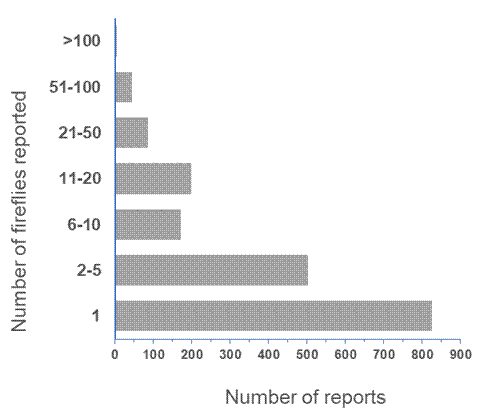
Most sightings and reports (Fig. 3) came from central Croatia. Zagreb County, Primorje-Gorski Kotar County and Zadar County had the most reports in all three years of the project. In 2019, there were over 100 notifications from these counties, while in 2020 the number of notifications dropped below 100. In 2021, these same counties were still the most active, but the number of notifications decreased to between 17 and 21. In 2019 and 2020, citizen scientists from 16 other counties were consistently active, reporting between 10 and 100 firefly occurrences. Virovitica-Podravina County and Vukovar-Syrmia County participated with less than 10 reports in the “Krešo the Firefly” project during all three years of the project. The largest number of fireflies (Fig. 4) was reported from central Croatia (capital and Zagreb County, Karlovac County), which is connected with the higher number of reports from these locations. In the other counties, the number of fireflies is similar and varies between
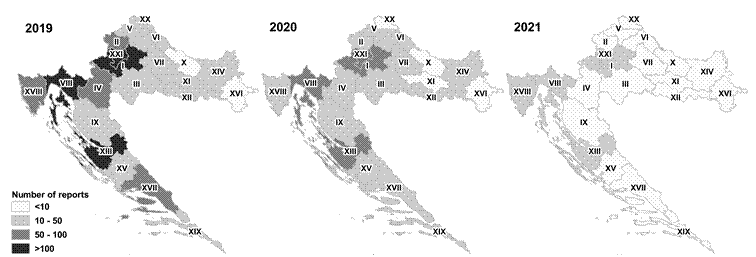
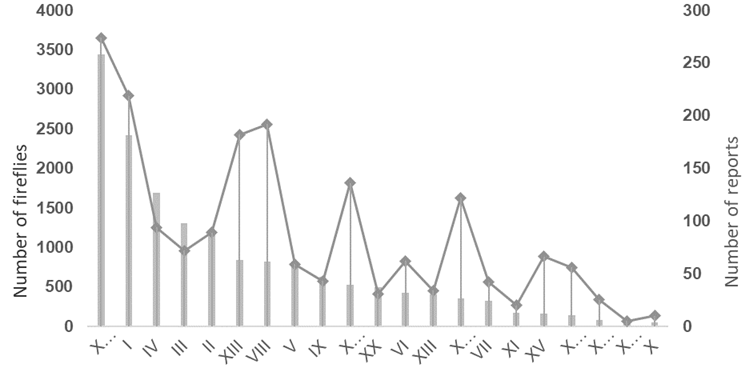
500 and 1300 and the number of reports between 70 and 130. On average, there were 1,2 reports per person (or citizen scientist), which means that in most reports a person reported the occurrence of fireflies only once. The maximum number of reports per person was six.
Citizen scientists classified by gender are shown in Figure 5. In all three years, the number of female citizen scientists was significantly higher than the number of male citizen scientists, ranging from 50 % to 100 % of participants. The proportion of male citizen scientists averaged less than 25 % throughout the study period.
DISSCUSION
Our study documented four different Lampyridae species and their occurrence and abundance throughout Croatia using a CS approach. Such data makes an important contribution to the conservation biology of the species documented, as shown by previous research[48] -[52] . While GBIF provides only 34 records of Lampyridae species on the territory of Croatia, Austria, Slovenia and Bosnia and Herzegovina[45] , we reported a considerable number of firefly occurrences (n = 1833) for all 21 counties of Croatia over a three-year period. The higher number of reports from central Croatia is consistent with the larger number of people living in this area. In 2020 and 2021, the number of sightings was lower due to the COVID 19 pandemic and the earthquake that hit the Capital, Zagreb and Sisak-Moslavina County. The COVID-19 pandemic was a setback for our project, as the movement of the Croatian population was restricted for a while and media had different focus priorities. The search for fireflies was not a priority for most people at the time. Nevertheless, we received positive feedback from several citizen scientists that this activity helped them feel better, be active in the fresh air and be useful in such unfortunate times. The same positive effect of participating in CS and feeling like they are contributing to society as a whole was also noted by Holden[53] . According to Groffman at al.[54] most CS projects are generally considered necessary to raise awareness of environmental issues, democratize science, and (re)establish trust between science and society. Our project succeeded in involving Croatia as a whole and the media in the search for fireflies, as most people have fond memories of balmy summer nights filled with firefly light displays.
Most of engaged volunteers were female reporters. The same trend, with a greater proportion of female reporters, was noted in the invasive species case study by Crall et al.[55] . Studies by Kwak and Radler[56] ; Underwood et al.[57] , report that, similar to traditional survey modes, women respond in greater proportions in online surveys than men. During the project, we found that the campaign had little impact in some counties (Virovitica-Podravina, Vukovar-Syrmia, Požega-Slavonia, and Osijek-Baranja), which may have affected the results. The most likely reason is the older population in rural areas as well as the fact that these counties are affected by drastic depopulation trends. Limited access to the Internet and social networks is most probable reason why the CS campaign and media surrounding did not reach these counties sufficiently. A similar example of lower participation of rural areas in a CS projects was highlighted by Holden[53] . Research by Kwak, and Radler, Underwood et al. and Vaske et al.[56] -[58] has shown that demographic factors, including place of residence, influence people's attitudes and values toward scientific research. According to Loenen et al.[35] , word of mouth and newspapers have been shown to work best for recruiting CS in rural areas. In our study, the primary focus for CS recruitment was the use of social media, while personal contacts and newspapers were limited sources. Researchers often use visual estimates to infer species frequency, and these estimates typically vary among observers[59] -[61] . In our study, most CS reported counting “the firefly” as only one specimen, while abundance was likely higher, which is consistent with the study by Crall et al.55, who found that volunteers and professionals tended to under- or overestimate the number of different species differently. The highest abundance in the whole of Croatia was recorded in the most densely populated areas with the highest number of young people actively involved in social networks. According to Stohlgren[62] , standardised monitoring protocols established by professionals and tested under realistic field conditions can improve data quality and analyses. In our study, photographs submitted by volunteer reporters were often of low quality and locations were poorly described. Some material could not be used to identify lampyrids and some locations could not be plotted on the map produced. According to Crall et al.[55] , photographing geolocated specimens may be better for verifying the accuracy of species identifications.
CONCLUSIONS
The dataset documented in this study is a valuable source of information for the scientific community, especially in the fields of entomology, conservation biology, and ecology. New communication tools and social science research can help scientists interact more effectively with the public. In this study, we were able to collect a large amount of data on individual firefly locations in each of the 21 counties and abundance per site. The basic demographic profile showed higher female activity in more populated areas (capital and larger cities), which provides good insight into preparation of future strategies for targeting the project to more rural areas and the male portion of the population. More focus on diverse and specific habitats, as well as monitoring of environmental factors, would further complete the dataset. The data collected as part of “Krešo the Firefly”, including the list of species occurring in Croatia, their abundance, locations, and original photographs, represent a high- quality dataset. Making these data available in open and machine-readable formats would certainly increase their reusability by other scientists and policy makers in Croatia, and ultimately help us protect and restore firefly diversity in Croatia. A collaboration with a team of experts from Biologer has already been established, and the transfer of the data into open databases according to the given specifications of their portal is underway. A data collection strategy for future research was also agreed upon. This research is a first attempt, at least in Croatia, to focus on this sensitive, endangered, poorly distributed and low abundant taxa. Although further collections in a wider range of habitats would be of further benefit, these data have provided a better understanding of Croatian fireflies and a good foundation for future work on firefly biodiversity and conservation in this region.

